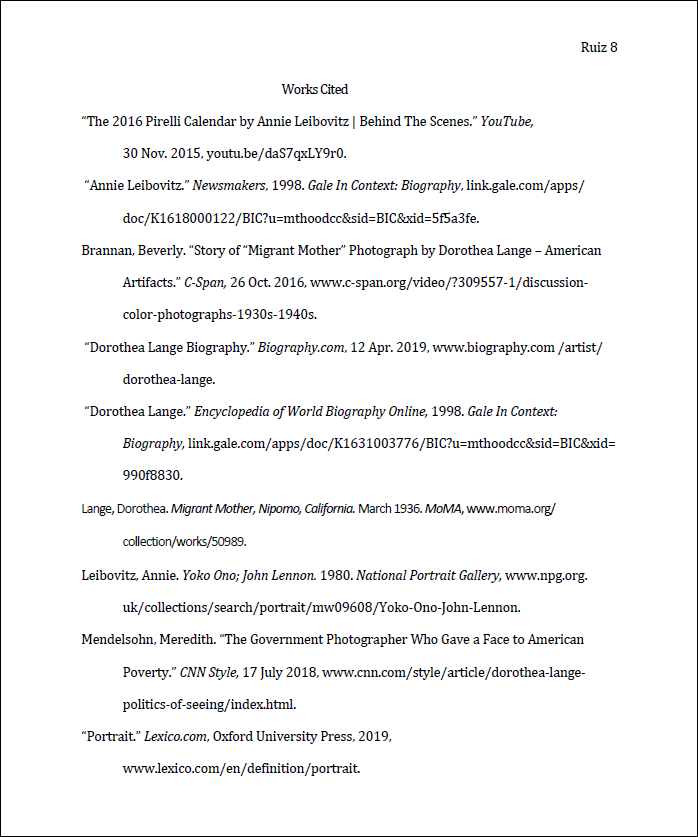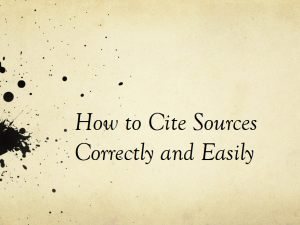Formatting Research
Preview
This appendix will cover the following topics:
- citing research
- avoiding plagiarism
Writing college assignments that includes research poses multiple challenges. One of the main issues is how to use materials ethically. This appendix focuses on how to format citations and avoid plagiarism.
Whether you quote, summarize or paraphrase, research must always be cited. “Citing” means formatting the information so it can’t be mistaken for your ideas.
Citing involves three components: a Works Cited page, signal phrases, and in-text citations.
Works Cited Page
A Works Cited page is an alphabetical list of the “works” you refer to in your paper, with the necessary information to find the source. When producing a research paper, write the Works Cited page first; the information that goes into signal phrases and in-text citations is based on the entries on the Works Cited page.
Writing a citation is like learning a code. Doing it correctly is crucial because otherwise the code can’t be translated accurately. The challenge is that each different kind of source is formatted differently.
There are tons of things you need to know about what goes into a citation and how to decipher it. Nobody has all of the rules of formatting citations memorized. To format citations correctly, students need a reference book. I recommend the following:
- A Pocket Style Manual by Diana Hacker and Nancy Sommers, if you want an actual book. It is cheap, easy to use, and accurate. Get the newest edition.
- The Purdue University Online Writing Lab at https://owl.purdue.edu/owl/purdue_owl.html if you want an online resource. It is free, easy to use, and accurate.
Here is what a basic citation looks like:
Adler, Mortimer. “How to Mark a Book.” Mercury Reader, edited by Gay Monteverde, Pearson, 2015, pp. 3-7.
Because the above citation is correctly formatted, I can translate it correctly. I know the item is an essay published in a book; it is in print, not electronic; the author is Mortimer Adler; the editor of the anthology is Gay Monteverde; the publisher of the book is Pearson; it was published in 2015; and the essay appears on pages 3-7. I know all this because of the way the information is presented.
Here is an example of a detailed Works Cited page:
 But a Works Cited page can also be just one entry, if you only used one source.
But a Works Cited page can also be just one entry, if you only used one source.
It takes a while to learn to do citations. Use a manual and go slowly.
Using Signal Phrases
A signal phrase introduces a quote, summary or paraphrase. For example:
According to Mortimer Adler, “There are three kinds of book owners.”
“According to Mortimer Adler” is a signal phrase. It signals that the following information is from research. If you don’t tell readers that information comes from research, they might assume that the ideas or words are yours. That is plagiarism (see below).
Although the usual place for a signal phrase is before the referenced information, signal phrases can appear in the middle or at the end too. A signal phrase is necessary whether quoting, summarizing, or paraphrasing.
People who own books, Adler explains, come in three types.
“There are three kinds of books owners,” Mortimer Adler claims.
Using In-text Citations
In-text citations are a brief note at the end of a quote, summary, or paraphrase that refers the reader to the full citation on the Works Cited page. Here is an example:
According to Mortimer Adler, “There are three kinds of book owners” (4).
That number “4” in parentheses at the end of the quote is the in-text citation. Using the signal phrase and the in-text citation, your reader can turn to the Works Cited page, find “Adler” there, and know that the quote is on page 4 of the document listed.
An in-text citation is necessary for summaries and paraphrases as well as quotes. For example:
People who own books, Adler explains, come in three types (4).
The in-text citation is placed at the end of the sentence, not the end of the quote:
“There are three kinds of books owners,” Mortimer Adler claims (4).
Note that the in-text citation comes before the end punctuation.
If the author listed on the Works Cited page is named in the signal phrase, as above, the in-text citation just includes a page number. If the author is not named, the in-text citation needs to include his name as well. For example:
I found this statement particularly interesting: “There are three kinds of book owners” (Adler 4).
As above, the period at the end of the sentence comes after the in-text citation.
Graphics
A Word About Plagiarism:
Don’t.
Students must give credit to the source of borrowed words and ideas, whether quoted, summarized, or paraphrased. If you need help understanding how to use sources ethically and effectively, talk to a teacher, a librarian, or a tutor.
But if your position about plagiarism is “Everybody else does it,” or “Who cares?” or “I’m in a hurry,” consider this:
- Plagiarism is cheating. It robs a student of an opportunity to learn and creates unfairness in grading.
- Plagiarism is stealing. It is the same thing as breaking into someone’s house and taking their stereo or grabbing an old lady’s purse on the street.
- Plagiarism is actually illegal. (See the Oregon Revised Statute 165.114). Many people have ended up in court, paying lots of money for plagiarizing the words or works of others. People who do not end up in court often lose their jobs and their reputations. College students can fail an assignment or an entire class.
Plagiarism is defined by our college as “the act of stealing ideas, passages, or writing of others and using them as one’s own, without acknowledgement or documentation…Common instances of plagiarism include such practices as ‘copying and pasting’ information from online sources, copying sentences from another student’s paper, turning in papers written by someone else, failing to credit the source of ideas, and incorrectly treating specialized information gained from sources as knowledge so widely held that it requires no documentation.”
Avoiding plagiarism is simple: Everything in the papers you write should either come from your own head or be cited.
Takeaways
- There is more to writing a research paper than citations, but knowing how to create a citation is a crucial skill.
- A Works Cited page lists all the reference material used in a research paper.
- Quotes, summaries and paraphrases must be formatted using signal phrases and in-text citations.
- Plagiarism is unethical and can have dire consequences. Don’t do it.
taking someone else's idea or words and presenting them as if they were yours
to identify the source of an idea or phrase
something done or made


